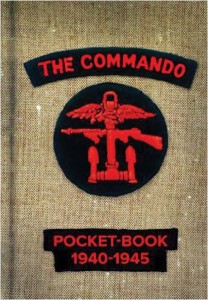Review by Larry S. Sterett | Contributing Editor
 THE COMMANDO POCKET MANUAL 1940-1945, compiled and introduced by Christopher Westhorp. ©2012. Published by the Naval Institute Press, Dept. TGM, 291 Wood Road, Annapolis, MD 21402. Price: $19.95, plus $5.50 for first book shipment. May also be available in some bookstores.
THE COMMANDO POCKET MANUAL 1940-1945, compiled and introduced by Christopher Westhorp. ©2012. Published by the Naval Institute Press, Dept. TGM, 291 Wood Road, Annapolis, MD 21402. Price: $19.95, plus $5.50 for first book shipment. May also be available in some bookstores.
This pocket-size 128-page hardbound book contains an excellent Introduction explaining the what, how and why of these special service groups based on the Boer kommando, plus ten brief chapters and an index. The chapters feature subjects from the original unit manuals of 1940-1945, and range from “Commando Training Instruction No.1, 1940”, to “Combined Operations Pamphlet No. 24: Cliff Assaults, 1945.” Some chapters are from the War Office, and others, such as chapter 4, “All-In Fighting,” written by W.E. Fairbairn, 1942, and Chapter 5, “Shooting to Live With the One-hand Gun,” by Fairbairn and E.A. Sykes, 1942, were authored by men well versed in their fields (Remember the Fairbairn-Sykes ‘Fighting Knife’ [dagger]?)
Illustrations in this volume consist of sketches—no photographs—and are mainly located in chapters 4, 5, 8, and 19. The correct positions for dispatching an enemy sentry silently, cliff scaling, and shooting positions are the subjects covered, and they definitely help explain the text. (The “Three-quarter Hip” position for handgun shooting was new to this reviewer and the illustration clarified it.)
The arms favored by the Commando units were basically the M1911 Colt, the Bren gun, and the Thompson. Although newsreel shots and similar views (movies?) show the Commandos carrying the M1928 Thompson with vertical fore grip and a 50-round drum magazine, this volume shows only the A1 version with the 20-round box magazine, horizontal forearm, and no barrel compensator. The vertical forearm is mentioned, and so is the simplified M1 Thompson. The M1911 and the Thompson used the same ammunition (.45 ACP) while the Bren used the British rifle round, the .303. (Special units also sometimes used other small arms, including the Welrod and Welgun, and the de Lisle carbine. All three were compact, suppressed or silenced firearms capable of killing at a reasonable distance.
Chapter 7 contains chapters 1, 3, 4, and 5, from the June 1944 Chief of Combined Operations pamphlet “Hardening of Commando troops for Warfare and notes on Field-Craft,’ with some good survival guidance. The original pamphlet was a summary of lectures given by a Surgeon Commander over a number of years, based on special training courses in the UK. Covered are such subjects as sleeping and cooking in the open, food rations, and even vitamins. Comments could apply to any hunter or disaster survivor planning on being out for more than one day.
Chapter 9 features notes from No. 4 Commando on the Dieppe Raid. The event occurred more than seven decades ago, but it provided the British will a morale boost in much the same way as the US Doolittle B-25 Raid on Tokyo did for Americans the same year.
This is an interesting volume. The Commandos were all volunteers—from the British Army, Royal Marines, or other Allied armies–trained initially as raiding parties. They needed to be tough, well-trained troops with a good variety of skills, and this book provides the reader a peek at how a recruit became a Commando.



